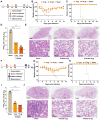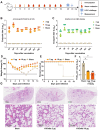A chimeric mRNA vaccine of S-RBD with HA conferring broad protection against influenza and COVID-19 variants
- PMID: 39303003
- PMCID: PMC11414905
- DOI: 10.1371/journal.ppat.1012508
A chimeric mRNA vaccine of S-RBD with HA conferring broad protection against influenza and COVID-19 variants
Abstract
Influenza and coronavirus disease 2019 (COVID-19) represent two respiratory diseases that have significantly impacted global health, resulting in substantial disease burden and mortality. An optimal solution would be a combined vaccine capable of addressing both diseases, thereby obviating the need for multiple vaccinations. Previously, we conceived a chimeric protein subunit vaccine targeting both influenza virus and severe acute respiratory syndrome coronavirus 2 (SARS-CoV-2), utilizing the receptor binding domain of spike protein (S-RBD) and the stalk region of hemagglutinin protein (HA-stalk) components. By integrating the S-RBD from the SARS-CoV-2 Delta variant with the headless hemagglutinin (HA) from H1N1 influenza virus, we constructed stable trimeric structures that remain accessible to neutralizing antibodies. This vaccine has demonstrated its potential by conferring protection against a spectrum of strains in mouse models. In this study, we designed an mRNA vaccine candidate encoding the chimeric antigen. The resultant humoral and cellular immune responses were meticulously evaluated in mouse models. Furthermore, the protective efficacy of the vaccine was rigorously examined through challenges with either homologous or heterologous influenza viruses or SARS-CoV-2 strains. Our findings reveal that the mRNA vaccine exhibited robust immunogenicity, engendering high and sustained levels of neutralizing antibodies accompanied by robust and persistent cellular immunity. Notably, this vaccine effectively afforded complete protection to mice against H1N1 or heterosubtypic H5N8 subtypes, as well as the SARS-CoV-2 Delta and Omicron BA.2 variants. Additionally, our mRNA vaccine design can be easily adapted from Delta RBD to Omicron RBD antigens, providing protection against emerging variants. The development of two-in-one vaccine targeting both influenza and COVID-19, incorporating the mRNA platform, may provide a versatile approach to combating future pandemics.
Copyright: © 2024 Hao et al. This is an open access article distributed under the terms of the Creative Commons Attribution License, which permits unrestricted use, distribution, and reproduction in any medium, provided the original author and source are credited.
Conflict of interest statement
Y.L.L., T.H., Y.B., B.Z., H.S. and G.F.G. are listed in the patent as the inventors of the influenza-COVID-19 chimeric protective vaccine. All other authors declare no competing interests.
Figures






Similar articles
-
A decavalent composite mRNA vaccine against both influenza and COVID-19.mBio. 2024 Sep 11;15(9):e0066824. doi: 10.1128/mbio.00668-24. Epub 2024 Aug 6. mBio. 2024. PMID: 39105586 Free PMC article.
-
Rational design of an influenza-COVID-19 chimeric protective vaccine with HA-stalk and S-RBD.Emerg Microbes Infect. 2023 Dec;12(2):2231573. doi: 10.1080/22221751.2023.2231573. Emerg Microbes Infect. 2023. PMID: 37394992 Free PMC article.
-
Pan-beta-coronavirus subunit vaccine prevents SARS-CoV-2 Omicron, SARS-CoV, and MERS-CoV challenge.J Virol. 2024 Sep 17;98(9):e0037624. doi: 10.1128/jvi.00376-24. Epub 2024 Aug 27. J Virol. 2024. PMID: 39189731 Free PMC article.
-
Novel universal influenza virus vaccine approaches.Curr Opin Virol. 2016 Apr;17:95-103. doi: 10.1016/j.coviro.2016.02.002. Epub 2016 Feb 27. Curr Opin Virol. 2016. PMID: 26927813 Free PMC article. Review.
-
SARS-CoV-2 Vaccines Based on the Spike Glycoprotein and Implications of New Viral Variants.Front Immunol. 2021 Jul 12;12:701501. doi: 10.3389/fimmu.2021.701501. eCollection 2021. Front Immunol. 2021. PMID: 34322129 Free PMC article. Review.
Cited by
-
Progress in combination vaccines and the co-administration of influenza virus and SARS-CoV-2 vaccines.Front Immunol. 2025 Jun 25;16:1578733. doi: 10.3389/fimmu.2025.1578733. eCollection 2025. Front Immunol. 2025. PMID: 40636108 Free PMC article. Review.
References
MeSH terms
Substances
Supplementary concepts
LinkOut - more resources
Full Text Sources
Medical
Miscellaneous

